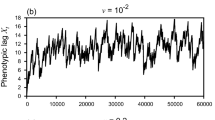Abstract
This sharpens the result in the paper Jagers and Zuyev (J Math Biol 81:845–851, 2020): consider a population changing at discrete (but arbitrary and possibly random) time points, the conditional expected change, given the complete past population history being negative, whenever population size exceeds a carrying capacity. Further assume that there is an \(\epsilon > 0\) such that the conditional probability of a population decrease at the next step, given the past, always exceeds \(\epsilon \) if the population is not extinct but smaller than the carrying capacity. Then the population must die out.
Similar content being viewed by others
Avoid common mistakes on your manuscript.
1 Three assumptions and one result
Denote population sizes, starting at time \(\tau _0=0\), by \(Z_0\), changing into \(Z_1, Z_2, \ldots \in {\mathbb {N}}\) at subsequent time points \(0< \tau _1 < \tau _2 \ldots \). Here \({\mathbb {N}}\) is the set of non-negative integers, and we make no assumptions about the times between changes. Let \({\mathscr {F}}_n\) be the sigma-algebra of all events up to and including the n-th change - i.e. really all events, not only population size changes - and introduce a carrying capacity \(K>0\), the population size where reproduction turns conditionally subcritical. More precisely:
Assumption 1
Further,
Assumption 2
There is no resurrection or immigration but, otherwise, a change is a change in population size:
Assumption 3
Non-extinct populations, smaller than the carrying capacity, run a definite risk of decreasing:
Then:
Theorem 1
Under the three assumptions given, the population must die out: with probability 1, \(Z_n = 0\) eventually.
The original paper (Jagers and Zuyev 2020) had a stronger third assumption, viz. that, whatever the population history, there must be a definite, strictly positive risk that the population size decreases by exactly one unit at the next change. This is not unnatural and can be interpreted as a possibility that a change involves no reproduction but merely the death of one individual. But it turns out to be unnecessary.
2 The proof
Like the original proof, this starts from stopping times \(\nu _1, \nu _2, \ldots \) and \(\mu _1, \mu _2, \ldots \), the former denoting the times of successive visits to the integer interval [0, K), the latter the subsequent first hittings of levels \(\ge K\). More precisely,
and for \(k=1,2, \ldots \) ,
As was noted, \(\nu _1<\infty \), whereas the \(\mu _k\) constitute an increasing sequence, possibly hitting infinity. Clearly, \(\nu _k< \infty , \mu _k=\infty \) means that the population dies out at or after \(\nu _k\), without ever reaching K again. Also for any k, \(\mu _k<\infty \Rightarrow \nu _{k+1} < \infty \). Proceeding like in the original paper, note that
and
But
For short, write
for the event that the n-th change is a decrease, provided \(Z_{n-1} >0\) (and of course the population remains extinct if \(Z_{n-1} =0\)). By Assumption 3, \(Z_n < K\) implies that
Since \(Z_n < K\) implies that \(Z_{n+K} =0\) on the set
and the population size never crosses the carrying capacity, we can conclude that
The theorem follows.
References
Jagers P, Zuyev S (2020) Populations in environments with a soft carrying capacity are entually extinct. J Math Biol 81(3):845–851. https://doi.org/10.1007/s00285-020-01527-5
Funding
Open access funding provided by Chalmers University of Technology.
Author information
Authors and Affiliations
Corresponding author
Additional information
Publisher's Note
Springer Nature remains neutral with regard to jurisdictional claims in published maps and institutional affiliations.
Rights and permissions
Open Access This article is licensed under a Creative Commons Attribution 4.0 International License, which permits use, sharing, adaptation, distribution and reproduction in any medium or format, as long as you give appropriate credit to the original author(s) and the source, provide a link to the Creative Commons licence, and indicate if changes were made. The images or other third party material in this article are included in the article’s Creative Commons licence, unless indicated otherwise in a credit line to the material. If material is not included in the article’s Creative Commons licence and your intended use is not permitted by statutory regulation or exceeds the permitted use, you will need to obtain permission directly from the copyright holder. To view a copy of this licence, visit http://creativecommons.org/licenses/by/4.0/.
About this article
Cite this article
Jagers, P., Zuyev, S. Amendment to: populations in environments with a soft carrying capacity are eventually extinct. J. Math. Biol. 83, 3 (2021). https://doi.org/10.1007/s00285-021-01624-z
Received:
Revised:
Accepted:
Published:
DOI: https://doi.org/10.1007/s00285-021-01624-z



